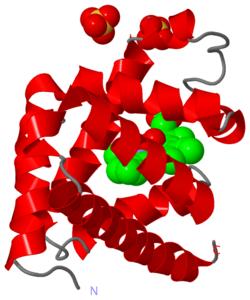JMS/sandbox15
From Proteopedia
(Difference between revisions)
| Line 14: | Line 14: | ||
Specifically, they predicted that species could increase the concentration of myoglobin by increasing its solubility through increasing the number of positively charged regions on the protein's surface, so that even at high concentration the electrostatic repulsion between the myoglobin proteins would prevent their aggregation. | Specifically, they predicted that species could increase the concentration of myoglobin by increasing its solubility through increasing the number of positively charged regions on the protein's surface, so that even at high concentration the electrostatic repulsion between the myoglobin proteins would prevent their aggregation. | ||
| - | '''Amazingly, they found an association''' between an animals' ability to hold its breath, higher concentrations of myoglobin in muscle tissue, and an increase in its net charge (taken as a ''proxy'' for an increase in the number of positively charged regions on the surface). Typically, purified terrestrial mammal's myoglobin has a solubility of 20 mg/g in an aqueous solution at neutral pH ([http://www.sigmaaldrich.com/content/dam/sigma-aldrich/docs/Sigma/Product_Information_Sheet/2/m0630pis.pdf Sigma Aldrich]) which turns out to be the maximum level of myoglobin found in most terrestrial mammal's tissue. But whales and other aquatic mammals far exceed this solubility limit, e.g., whales have 70 mg/g. The way that they overcome the solubility constraint may be traced back to a modest increase in the net charge of myoglobin - from around +2 in terrestrial animals to around +4 in aquatic animals. | + | '''Amazingly, they found an association''' between an animals' ability to hold its breath, higher concentrations of myoglobin in muscle tissue, and an increase in its net charge (taken as a ''proxy'' for an increase in the number of positively charged regions on the surface). Typically, purified terrestrial mammal's myoglobin has a solubility of 20 mg/g in an aqueous solution at neutral pH ([http://www.sigmaaldrich.com/content/dam/sigma-aldrich/docs/Sigma/Product_Information_Sheet/2/m0630pis.pdf Sigma Aldrich]) which turns out to be the maximum level of myoglobin found in most terrestrial mammal's tissue. But whales and other aquatic mammals far exceed this solubility limit, e.g., whales have 70 mg/g. The way that they overcome the solubility constraint may be traced back to a modest increase in the net charge of myoglobin - from around +2 in terrestrial animals to around +4 in aquatic animals.<ref>https://pdb101.rcsb.org/motm/1#:~:text=PDB%2D101%3A%20Molecule%20of%20the%20Month%3A%20Myoglobin.</ref> |
---- | ---- | ||
| Line 28: | Line 28: | ||
Another way to say this, in the case of proteins <scene name='57/575026/Electrostatics/16'>in solvents such as water</scene>, is that, for each and every protein, <scene name='57/575026/Electrostatics/24'>water binds to the hydrogens</scene> (e.g., lysine's ammonium at physiology pH has three hydrogens - not shown) coming off a positively charged atom, or associates with the charged atom itself, thus screening each protein from the other proteins. | Another way to say this, in the case of proteins <scene name='57/575026/Electrostatics/16'>in solvents such as water</scene>, is that, for each and every protein, <scene name='57/575026/Electrostatics/24'>water binds to the hydrogens</scene> (e.g., lysine's ammonium at physiology pH has three hydrogens - not shown) coming off a positively charged atom, or associates with the charged atom itself, thus screening each protein from the other proteins. | ||
| - | Still, this picture is incomplete. While illustrative of the basic principles of how small electrostatic fields changes can greatly increase a protein's solubility, there other contributing factors to the electrostatic field, e.g., solvated ions, crowding conditions, and the neighboring residues to these divergent residues. For example, when a negatively charged residue neigbors one of these additional positive residues, then from a distance relatively larger than the distance between the two oppositely charged residues, the electrostatic field is zero | + | Still, this picture is incomplete. While illustrative of the basic principles of how small electrostatic fields changes can greatly increase a protein's solubility, there other contributing factors to the electrostatic field, e.g., solvated ions, crowding conditions, and the neighboring residues to these divergent residues. For example, when a negatively charged residue neigbors one of these additional positive residues, then from a distance relatively larger than the distance between the two oppositely charged residues, the electrostatic field is zero. |
<!-- | <!-- | ||
Revision as of 08:41, 17 August 2023
| |||||||||||
References:
- ↑ 1.0 1.1 Mirceta S, Signore AV, Burns JM, Cossins AR, Campbell KL, Berenbrink M. Evolution of mammalian diving capacity traced by myoglobin net surface charge. Science. 2013 Jun 14;340(6138):1234192. doi: 10.1126/science.1234192. PMID:23766330 doi:http://dx.doi.org/10.1126/science.1234192
- ↑ https://pdb101.rcsb.org/motm/1#:~:text=PDB%2D101%3A%20Molecule%20of%20the%20Month%3A%20Myoglobin.
- ↑ Brocchieri L. Environmental signatures in proteome properties. Proc Natl Acad Sci U S A. 2004 Jun 1;101(22):8257-8. Epub 2004 May 24. PMID:15159533 doi:http://dx.doi.org/10.1073/pnas.0402797101
- ↑ Goh CS, Lan N, Douglas SM, Wu B, Echols N, Smith A, Milburn D, Montelione GT, Zhao H, Gerstein M. Mining the structural genomics pipeline: identification of protein properties that affect high-throughput experimental analysis. J Mol Biol. 2004 Feb 6;336(1):115-30. PMID:14741208 doi:http://dx.doi.org/10.1016/S0022283603014748

